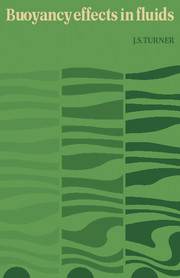Book contents
- Frontmatter
- Contents
- Preface
- 1 INTRODUCTION AND PRELIMINARIES
- 2 LINEAR INTERNAL WAVES
- 3 FINITE AMPLITUDE MOTIONS IN STABLY STRATIFIED FLUIDS
- 4 INSTABILITY AND THE PRODUCTION OF TURBULENCE
- 5 TURBULENT SHEAR FLOWS IN A STRATIFIED FLUID
- 6 BUOYANT CONVECTION FROM ISOLATED SOURCES
- 7 CONVECTION FROM HEATED SURFACES
- 8 DOUBLE-DIFFUSIVE CONVECTION
- 9 MIXING ACROSS DENSITY INTERFACES
- 10 INTERNAL MIXING PROCESSES
- Bibliography and Author Index
- Recent Publications
- Subject Index
- Plate section
7 - CONVECTION FROM HEATED SURFACES
Published online by Cambridge University Press: 05 August 2012
- Frontmatter
- Contents
- Preface
- 1 INTRODUCTION AND PRELIMINARIES
- 2 LINEAR INTERNAL WAVES
- 3 FINITE AMPLITUDE MOTIONS IN STABLY STRATIFIED FLUIDS
- 4 INSTABILITY AND THE PRODUCTION OF TURBULENCE
- 5 TURBULENT SHEAR FLOWS IN A STRATIFIED FLUID
- 6 BUOYANT CONVECTION FROM ISOLATED SOURCES
- 7 CONVECTION FROM HEATED SURFACES
- 8 DOUBLE-DIFFUSIVE CONVECTION
- 9 MIXING ACROSS DENSITY INTERFACES
- 10 INTERNAL MIXING PROCESSES
- Bibliography and Author Index
- Recent Publications
- Subject Index
- Plate section
Summary
The problems which arise when the buoyancy sources are distributed over a surface, rather than being localized, are rather different from those treated in the previous chapter. Often the temperature difference between the fluid and the surface or between two surfaces is now specified, and the heat flux is not given but is a derived quantity which it is desired to predict. Attention is shifted from the individual elements to the properties of the mean flow and buoyancy fields, since it is not clear at the outset what form the buoyant motions will take. As we shall see later in this chapter, however, the details of the observed flows can only be properly understood if we again consider the buoyant elements explicitly and try to understand how their form and scale is determined by the boundary conditions (which in many cases are nominally uniform over the solid surface).
There is also the new feature of stability to be discussed here. A point source of buoyancy in an otherwise unconstrained perfect fluid always gives rise to convective motions above or below it, with an associated production of vorticity, and the same is true of a horizontal interface with the lighter fluid below (see §1.2). In a real fluid, however, the criterion based on (1.2.1) is no longer sufficient to determine whether a horizontal layer of fluid is gravitationally unstable or not; even when the fluid is lighter below, molecular viscosity and diffusion can act to damp out small disturbances, so that no overturning occurs.
- Type
- Chapter
- Information
- Buoyancy Effects in Fluids , pp. 207 - 250Publisher: Cambridge University PressPrint publication year: 1973

